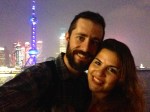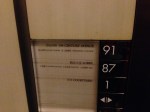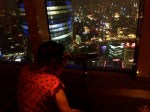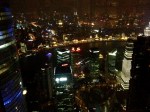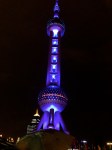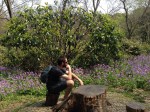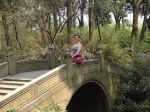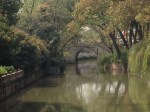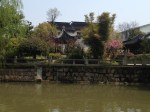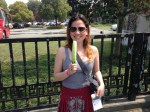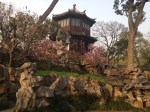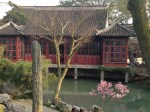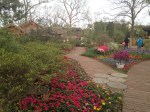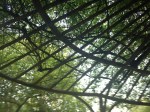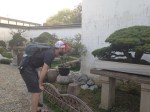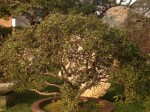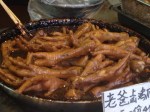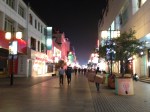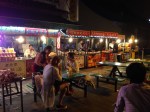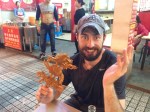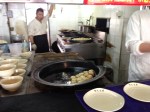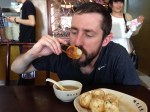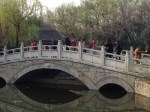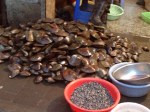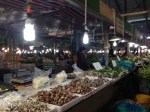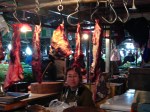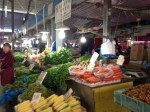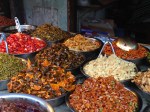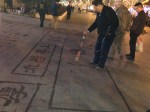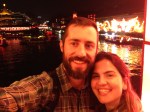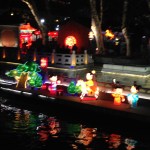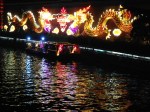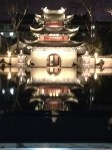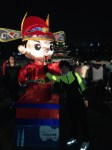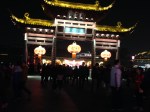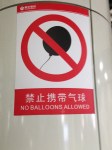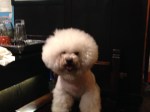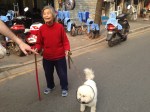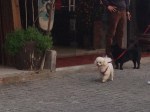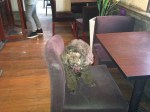
Somewhere Upon the Sea
Shanghai上海:
上: “Shang” means “upon” or “beside”
海: “Hai” means “Ocean”
Not really a beach town …
Greetings from the Future, Dear Readers!
Today’s post brings us to Shanghai, where you can order noodle soup, dumplings, and a beer in a marble-columned building constructed in the 1800s with drug money. Do you like neon? Do you like staying awake all night? Do you like making money, how do you feel about spending it? Shanghai is loud, brash, fast, and beautiful. It is London, New York, Las Vegas, Paris, and a wild west outpost with a retired sheriff.
Of the foreign “backpackers” in our hostel, we met a British man working three jobs (modeling, bartending, and entry-level clerking for a fashion design company) and a Mexican man who was working to import avocados. They were sharing halves of a bunkbed. I seem to remember the Brit having turned the lower berth into an office of sorts. A large number of the native Chinese at the hostel were clearly working out of the building as well. A noted change from your average Australian 20 something, Brit-on-a-gap-year, or Israeli fresh out of service to the IDF. That said, this city has plenty to do for those looking to take a trip.
Looking for enormous buildings that take the form of decommissioned rocket ships? Got it.
European architecture? Yes! Traditional, Asian architecture? We can probably find something for you, but let’s not get too crazy with these requests. Delicious, local fare? You bet! How about Indian restaurants, French food, and a place you can get fresh bagels and a good cup of coffee? You’re in luck!
I’ll get to some of the sights, but first I want to explain some context (feel free to skip ahead, pretty pictures at the bottom).
When trying to understand Shanghai, one must take into account its history and importance politically, economically, and geographically.
Politically, you can think of Shanghai as an influencer but not a decider. Shanghai is a New York of sorts, but not at all a Washington DC. People make money here and couldn’t care much for policy. Shanghai is a hub of business and finance on mainland China, which also dabbles in fashion, whereas Beijing is a hive of manufacturing and, within the last decade, tech.
Geographically, Shanghai is positioned as not only an excellent port for exporting Chinese goods but also importing. Shanghai is a gateway to the Yangtze basin, which represents hundreds of millions of people, all within a very short distance. Suzhou is 35 minutes on a train and Nanjing is another hour, all representing 20 million people beyond the 24 million in Shanghai. This does not tally Wenzhou, Hangzhou, or any points south. Read: a lot of people, really close by.
Economically, Shanghai boasts the most profitable commercial center in China, which translates to a noted cultural rift with the rest of the Middle Kingdom. The urban/rural divide, while present in the West, poses a more significant division in China due to a more pronounced wealth disparity. A farmer in Wedowee, Alabama might not have really “got” Seinfeld, not being able to sympathize with the daily stresses of a womanizing standup comedian who lives off of cereal in Manhattan, but the farmer and Jerry could probably both talk about baseball or something … By comparison, a farmer in Qinghai Province might never have had antibiotics, so the prevalence of Lamborghini dealerships in Shanghai is probably going to cause a long, awkward silence while searching for something to talk about. (There are two Lamborghini dealerships in Shanghai, that we saw.) Get the difference?
For well over a hundred years, American boat captains with Philippine crews, German engineers, and French cooks (throw darts at a map and create different combinations at home!) disembarked in Shanghai, rendering the city about as traditionally Chinese as Manhattan is “Field of Dreams.” This cultural separation between Shanghai and the heartland of China has bred distrust.
Politicians in Beijing, for hundreds of years, have actively worked to mitigate the city’s influence on national policy. In the 1700s, Shanghai boasted the most profitable port on the Yangtze, despite being designated as something less influential than a county seat. Hundreds of years later, the city remains a place that produces wealth for the country, with little influence on the Communist Party’s overall governance. 1983 saw Shanghai’s tax contribution 33 times less than that invested by the PRC. Shanghaiers are paving Beijing’s roads.
Do Shanghaiers look down on the rest of those in China? Maybe? Do New Yorkers talk of civilization ending at the Hudson River? There’s some frustration on both ends.
Chinese friends have told me that, “Beijing turns foreigners Chinese, while Shanghai turns the Chinese foreign.” As mentioned above, the port has proved profitable, thereby enticing foreign investment. That said, the history of Shanghai’s foreign involvement was shaped as much by the port as by the products being shipped.
The 1,400 pound elephant in the room:
Imagine, if you will, a product that customers will gladly buy, regardless of price hikes, legal restrictions, or negative health consequences. This product, when used outside the prudent restrictions of medical professionals, breeds large numbers of of people who show up late to work and are generally bad at raising children. Now, imagine you have a lot of this product and a good idea of a place you can sell it, far from your home where you might have to … you know … deal with the consequences.
In 1838, the UK was selling 1,400 pounds of opium, per year, from fields in India, to buyers in China. Simultaneously, the penalty for native Chinese opium dealers was death. This came to a head with the Opium Wars, which initially decided that European and American merchants could ship opium to China. This climate made financial empires.
Opium’s previous influence on Shanghai’s economy (and the world’s) cannot be underestimated. The long gone British East India Company’s most profitable endeavor was in opium trade. Jardine Matheson (they focus on shipping, but have expanded into the role of a holding company. The trucks with the ladders on them in Hong Kong’s airport are owned by Jardine) posts 57 billion USD in annual revenue today and was started by a doctor who found it more profitable to abandon his practice prescribing this wonder drug and simply focus on shipping it. Heard of HSBC? The Hong Kong and Shanghai Banking Corporation was started in the wake of the Opium Wars as a means of putting all this drug money somewhere other than a mattress.
Shanghai’s architecture and overall layout are owed to foreign concessions with architecture built by European, Japanese, and American corporations. A walk through the city can, at times, look very much like Paris, especially if one is in the French Concession. A walk along the Huang Pu River on The Bund is straight out of Europe. The most prominent buildings: the former HSBC headquarters, the former French Consulate, the former headquarters of Jardine Matheson, all boast Greek columns, domes, spires, and were paid for with drug money.
That said, the Chinese idiom of “旧的不去新旳不来” (jiu de bu qu, xin de bu lai), or, “If the old doesn’t go, the new won’t come,” applies in Shanghai. The city, like others across China, is in constant flux, with old buildings being razed to make room for new skyscrapers. Hard to argue with progress.
Today, of course, the economy is decidedly less smack-focused. We had an absolute blast in this city, here are some of the spots we enjoyed the most.
• The Bund: The Huangpu River cuts Shanghai in half, dividing the older part of the city, in the west, with its foreign concessions (this area is known as Puxi) from the newer half of the city, with some of the largest buildings in the world in the east (known as Pudong). The Bund is located on the Puxi side and allows one a walk along the river where you can simultaneously view old, European buildings and peer over the river to see a dizzying light display every night on some of the tallest buildings in the world.
• The World Financial Center: Pudong’s skyscrapers all have observation decks which charge admission fees. The Oriental Pearl Tower, which looks like a rocket ship or series of basketballs balanced on chopsticks depending on who you ask, charges over $20 to get to the top. To avoid these fees, long wait lines, and get an upholstered chair along with a telescope, we would suggest making your way to the building in Pudong that looks like a beer-bottle opener. (Look to the opening photo for this post, which is the Pudong Skyline. The World Financial Center building is the tall rectangle with a square missing from the center of it.) Avoid the line for the official observation deck and go tell the attendant at the front that you want to go to “the hotel lobby.” From here, you will be directed to an elevator with two available floors: 1 and 87. You’ll be 20 or 30 floors shy of the actual top floor, but you can have a drink and sit in a comfortable chair for less than the cost of the observation deck. To cross the river from our hotel in Puxi, we took something called the “Shanghai tourist tunnel,” which was very expensive, but was less a subway and more of a lightshow.
• The French Concession: While I never figured out the exact parameters of this area, a good amount of the city was previously under French governance and a lot of this area is still preserved with European architecture. Have you been in Asia for a while and are you looking for some western food? This is where you go. Here, in the French Concession, you will encounter people who can’t count to 5 in Chinese, eating steaks. It is pretty expensive compared to mainland China standard prices, but pretty standard for the U.S.
• The Shanghai Museum: A fantastically curated, free, museum that will take you through everything from the history of Chinese painting, ceramics, weaponry, money, as well as one fascinating exhibit on some of the different minority cultures in China. A very worthwhile stop.
• The Propaganda Museum: A hard-to-find (located in the basement of what seemed to be an apartment building) but very interesting exhibit on communist propaganda. A great place to grab a souvenir.
• Tianzifang (AKA “Tons of Fun”): Located in the French Concession off of Tai Kan Lu, this refurbished neighborhood of tight alleys and old buildings is reminiscent of Beijing’s hu tong neighborhoods. The only difference is that instead of the buildings being full of nice Chinese families, they’re full of bars selling giant mango mojitos. If you’re averse to being in a very crowded area and aren’t in the mood for a very touristy setting, steer clear. That said, there is much fun to be had.
• Bagelhead: They had bagels. They had coffee. They had bacon. I’m sure you can Google it.
• Local Fare: Xiao long bao and Shanghai sheng jian bao: While both of these foods were claimed by other cities on our trip, I figure it is worth reminding those reading that you can get these delicious foods in Shanghai as well. The sheng jian bao were the slightly sweet, flour dumplings, filled with meat and soup, while the xiao long bao were the thin-skinned dumplings.
Our photos of Shanghai are a bit sparse. The shortage can be blamed on the rain that poured down most of the time we were there and those aforementioned mango mojitos. Still, here are a few photos of the Shanghai at night:
